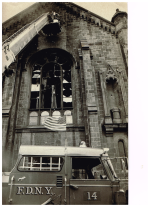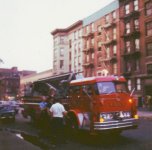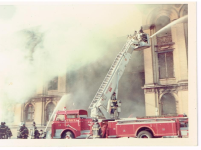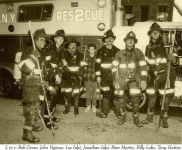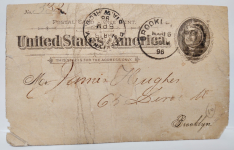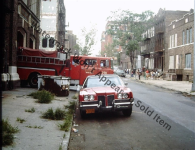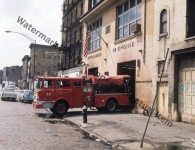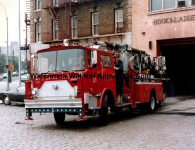You are using an out of date browser. It may not display this or other websites correctly.
You should upgrade or use an alternative browser.
You should upgrade or use an alternative browser.
A LOOK BACK.
- Thread starter 68jk09
- Start date
- Joined
- Sep 3, 2024
- Messages
- 124
In this great picture of history I noticed for the first time what appears to be a "Chief's car" with a bell mounted in/on the right front grille. I've never seen that before. At least not out here on the Island.A great photo taken by Wesley Pearman in January of 1970 on East Fordham Rd in the Bronx. There is an old saying that every picture is worth a thousand words. This is certainly one of them. What I found most amazing about this photo and several others taken from this job (floating around the internet) is that it captured an era of rapid modernization in FDNY fleet. In this picture alone you can see a Ward LaFrance gasoline motor hand cranked wooden aerial (a reserve piece that Ladder 33 was using). I am told that a few companies around the city were regularly using these as late as 1974. Directly behind this rig is a new 1968 series American LaFrance covered cab roof, diesel powered motor with vertical exhaust pipe (loud, especially under the Els) with a 100 foot steel aerial. Satellite 2 is operating in the only 5 year old Super Pumper System and Satellite 3 was also placed into operation at this job. Visible in the right background is one of the 1969 series Mack CF diesel powered pumpers with the Conestoga Herculite Hosebed cover. And not visible in this photo, but in others taken from this job that morning was Tower Ladder 44 operating. TL44 was one of the first 5-10 tower ladders to be placed into service starting in 1965 and was quickly being discovered as an invaluable fire killer as the Bronx was burning. Lastly, first alarm company E75 was not even in the top 25 citywide for runs or worker when this photo was taken. 5 years later they would be # 1 in the city. 33 truck would vault to #1 or 2 as the fire storm roared out of the south Bronx into the 19th Battalion. 33 truck was the only truck from Webster Avenue to the Harlem River and from the Cross Bronx Expressway to Kingsbridge Road, (ladders 56 and 59 had not been assigned to E48 and E43 yet), and in 71 or 72, Ladder 33 was issued a new tower ladder and was being special called all over the northwest Bronx and upper Manhattan. I lived in this area as a teenager before we bailed in 1975 along with 10’s of thousands of others for the suburbs. Lastly over the decades the taxpayers along Fordham road from Sedgwick Ave over to Southern Boulevard were notorious for multiple alarm jobs over from the 60’s and into the 21st century. Great times and great memories. Thanks for posting Chief JK.
From this web site "FDNY - Something Different" date May 8, 2012.
Reply # 15 - I posted this:
"As I remember it, Ladder 1 and Ladder 14 were the first Mack Tower Ladders.
Then Ladder 114, a Stuphen tower ladder went into service.
But that was after several Mack TLs were already in service.
Then Ladder 14 got a Stuphen also.
But still, Mack was the main provider of most of the Tower Ladders.
Then Ladders 14 and 163 got ALF rear mounts with front bucket.
Those were Big massivre ALFs
After several more years, Mack provided the Tower Ladders and some 95 footers then went into service.
Then came Seagraves.
www.nycfire.net/forums/threads/fdny-something-different.16181/
Reply # 15 - I posted this:
"As I remember it, Ladder 1 and Ladder 14 were the first Mack Tower Ladders.
Then Ladder 114, a Stuphen tower ladder went into service.
But that was after several Mack TLs were already in service.
Then Ladder 14 got a Stuphen also.
But still, Mack was the main provider of most of the Tower Ladders.
Then Ladders 14 and 163 got ALF rear mounts with front bucket.
Those were Big massivre ALFs
After several more years, Mack provided the Tower Ladders and some 95 footers then went into service.
Then came Seagraves.
www.nycfire.net/forums/threads/fdny-something-different.16181/
Last edited:
- Joined
- Sep 7, 2020
- Messages
- 2,616
Yes the two Sutphens entered service in 1980.From this web site "FDNY - Something Different" date May 8, 2012.
Reply # 15 - I posted this:
"As I remember it, Ladder 1 and Ladder 14 were the first Mack Tower Ladders>
Then Ladder 114, a Stuphen tower ladder went into service.
But that was after several Mack TLs were already in service.
Then Ladder 14 got a Stuphen also.
But still, Mack was the main provider of most of the Tower Ladders.
Then Ladders 14 and 163 got ALF rear mounts with front bucket.
Those were Big massivre ALFs
After several more years, Mack provided the Tower Ladders and some 95 footers then went into service.
Then came Seagraves.
www.nycfire.net/forums/threads/fdny-something-different.16181/
he 1st Tower Ladder was Ladder 1, 2nd was Ladder 14, 3rd was Ladder 119.Thanks Cap. Good stuff.
Yes the two Sutphens entered service in 1980.
Yes and "Atlas" you are correct, it was Ladder 119 a Sutphen, not L 114 as I reported earlier in reply 603.
- Joined
- Apr 25, 2008
- Messages
- 722
Went to St. John’s University with Pete Martin. A gentleman.
I worked with Bob Cicero’s father, Nick in E 5. He was a proby at the 23rd St fire and was told to wait at the top of the stairs to the cellar, when he noticed a lot of debris being sucked down the stairs, that’s when he started yelling for everyone to get out, saving the lives of 2 companies, E 5 and L 3.
- Joined
- May 6, 2010
- Messages
- 17,440
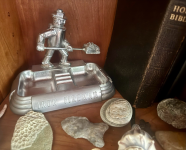 ^^^^^ IRON FIREMAN PROMOTIONAL ASHTRAY.
^^^^^ IRON FIREMAN PROMOTIONAL ASHTRAY. 
1920’s Art Deco Fireman Pen Holder Tray Trinket Dish Calling Card Cigar Ashtray | eBay
Up for your consideration is a stunning 1920’s Iron Fireman pen tray. He was a British Military Officer during World War II and later a Diplomat. It is always a conversation piece. This product is a rare and collectible 1920's Art Deco fireman pen holder tray trinket dish, featuring a unique...
www.ebay.com
- Joined
- Mar 28, 2021
- Messages
- 25
When the tower ladders started to appear how soon did the fdny realize the value of the tower ladders from keeping the war years becoming worse than what it was.
Was that the reason why fdny started using tower ladders because the increase in fires every year beginning from the mid 60s or was it just piece of apparatus fdny started using and never knew the value it would have during the war years.
I was from the south bronx before we moved to jersey because of all the fires but one thing I remember was those tower ladders and how much fire they would knock down when vacant tenements were fully involved all floors front to back with only 1 maybe 2 engines and tower ladder.
Was that the reason why fdny started using tower ladders because the increase in fires every year beginning from the mid 60s or was it just piece of apparatus fdny started using and never knew the value it would have during the war years.
I was from the south bronx before we moved to jersey because of all the fires but one thing I remember was those tower ladders and how much fire they would knock down when vacant tenements were fully involved all floors front to back with only 1 maybe 2 engines and tower ladder.
- Joined
- Mar 3, 2007
- Messages
- 1,593
I think the FDNY realized early on (probably after TL 1 and TL 14 showed their capabilities) just how valuable tower ladders were. The original plan was one tower per division, but after they "proved themselves" that changed to almost one per battalion and in some cases two per battalion. Although slower to set up than an aerial, the tower is a good, steady work platform with pinpoint accuracy of its master stream.When the tower ladders started to appear how soon did the fdny realize the value of the tower ladders from keeping the war years becoming worse than what it was.
Was that the reason why fdny started using tower ladders because the increase in fires every year beginning from the mid 60s or was it just piece of apparatus fdny started using and never knew the value it would have during the war years.
I was from the south bronx before we moved to jersey because of all the fires but one thing I remember was those tower ladders and how much fire they would knock down when vacant tenements were fully involved all floors front to back with only 1 maybe 2 engines and tower ladder.
- Joined
- Apr 23, 2018
- Messages
- 1,174
Tower-Ladders In the firestorm of the late 1960s and early 1970s, there was an enormous increase in the number of fires in New York City. In conjunction with these fires, the FDNY were subjected to a marked increase in firefighter injuries. Many of these injuries occurred while fighting fires in vacant buildings. Typically, these vacant buildings contained no life hazard, except to the responding firefighters. The FDNY attempted to solve this problem by introducing the Tower-Ladder in 1964. The TowerLadder provided the means to fight vacant building fires from outside the buildings, using the apparatus’ large-caliber stream, thus reducing the need to commit members to the building’s interior. The Tower-Ladder also gave the option to place a mobile rescue platform in front of the building to be used if the need should arise. As the FDNY entered the new century, although the frequency of vacant building fires has been reduced, the role of the TowerLadder as a viable firefighting tool has not been diminished.


I spent many days and nights hanging out across the street from that firehouse.
It became famous when the late FDNY Firefighter Denis Smith wrote the book "Report From Engine Co 82" in 1972 as the busiest Engine Co in the City.
The FDNY War Years had begun.
It became famous when the late FDNY Firefighter Denis Smith wrote the book "Report From Engine Co 82" in 1972 as the busiest Engine Co in the City.
The FDNY War Years had begun.

